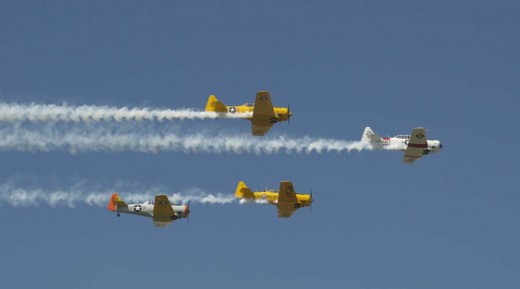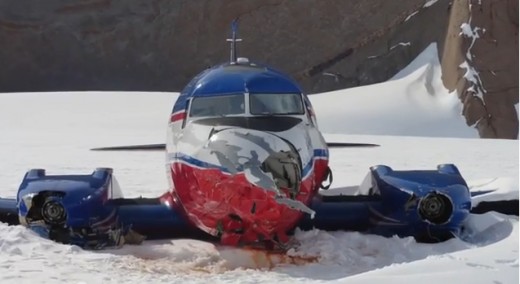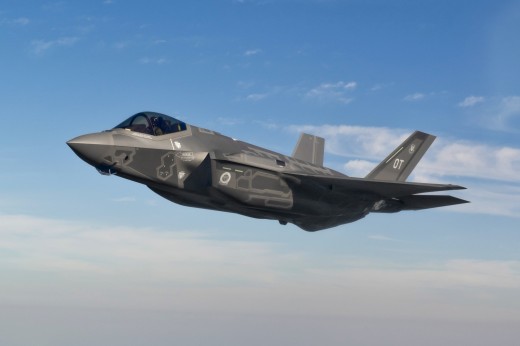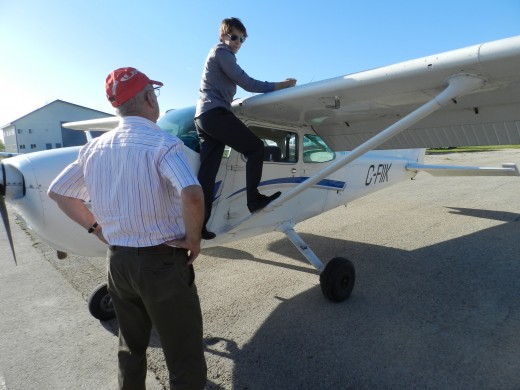
Scroll Down to see all of this week’s updates
Sun ‘n Fun Draws Canadians South

After the winter most Canadians endured, the “official” start to the air show season, Sun ‘n Fun in Lakeland, FL, was especially popular with Canadians this year.
Lots of Canadians make the southern migration every April for the show, which runs until Sunday at Lakeland Linder Regional Airport. Canadian exhibitors were all over the grounds and the flag was being flown at every turn.
Diamond Aircraft returned to Sun ‘n Fun with a large display that includes its latest DA42 model with turbocharged Austro diesel engines. Zenith has a large display featuring its new 750 Cruzer and Rotech Research is there with Rotax and the new sport model of the fuel-injected 912iS engine.
Canadian Aviator’s Jim Cole is there this week and has provided a gallery of photos.
WestJet Adds to Encore Fleet

Westjet has exercised options on five more Q400 turboprops for its regional carrier Encore and when the planes are delivered in 2015 the fleet will number 25.
The company also has 20 more options it can exercise from 2016 to 2018 as it broadens its reach into markets that don’t profitably sustain Boeing 737 jet service.
“While the Q400 NextGen aircraft is well known for its efficiency on short-haul missions, we have also been able to leverage its jet-like speed to reach new destinations and connect cities further apart, and this will be instrumental as we look to expand Encore’s service offering to our guests in Eastern Canada,” WestJet CEO Gregg Saretsky said in a statement.
Of course, as Encore moves east, a prime market at Billy Bishop Toronto City Centre Airport becomes attainable with the Q400s. Westjet’s 737s aren’t allowed into Billy Bishop but Encore could compete directly with Porter Airlines and Air Canada in the increasingly important market. The Q400 can reach most major markets in eastern Canada and the U.S. Eastern Seaboard from Billy Bishop.
Encore now flies as far east as Toronto but most of its 16 destinations are in western Canada.
Kenn Borek’s Lidia Flies Home

One of the most impressive aircraft recovery efforts ever undertaken was completed successfully in January and a fascinating web video of it was posted by Don Wray, an Alaska outfitter who was on the support crew.
Lidia, a Basler BT-67 operated by Kenn Borek Air, of Calgary for Antarctic Logistics Centre International, was heavily damaged in a takeoff accident on the Holtanna Glacier in Antarctica on Dec. 20, 2012. The aircraft hit a hidden ice fissure and the gear collapsed and the props tore away.
After some head scratching, Kenn Borek decided the aircraft could be repaired and flown off the glacier. After more than 40 days of concentrated effort, Lidia pulled herself out of the hole in the glacier under her own power and then took off to resume her productive life.
The preceding weeks involved an inspiring mix of grit, ingenuity and consummate skill as the Kenn Borek technicians installed a new cockpit section, repaired gaping holes in the rest of the airframe, installed new landing gear and prop gear.
The crew fought storms and numerous other challenges to raise the aircraft and ultimately fly it away. It was flown to Calgary in January of this year, spent the winter in a cozy hangar, and will be deployed back to Antarctica for the next season.
Software, Cost Problems Raised in F-35

A Government Accountability Office report to the U.S. government is warning of more delays in the development of the F-35 fighter but the software problems cited likely wouldn’t have any impact on any future Canadian order.
The GAO says the software packages that control the basic flight parameters and warfighting functions will take at least an extra 13 months to build. There are more than 24 million lines of code to run the various systems in the aircraft and software development has been an often-mentioned challenge.
There are about 100 F-35s flying but most of those outside Lockheed Martin’s test fleet are used for demonstration and training and have basic software that allows limited utility. The manufacturer has said the final software versions should be ready in 2015 but the GAO says that’s in question.
The GAO is also concerned about escalating costs of the program and says the Pentagon will have to pour more development money into the project over the next few years.
“Annual funding of this magnitude clearly poses long-term affordability risks given the current fiscal environment,” said the review.“The program has been directed to reduce unit costs to meet established affordability targets before full-rate production begins in 2019, but meeting those targets will be challenging as significant cost reductions are needed.”
Canada is still listed as one of nine nation partners in the development of the F-35 but the Harper government has not said whether it will remain in the program or allow an open bid for the replacement of the RCAF’s old fleet of well-used CF-18s.
Evolution of the Webster Competition

The annual Webster Memorial Trophy Competiton to pick Canada’s best amateur pilot is in the advanced planning stages and will culminate with the flying and written competitions among the regional finalists starting Aug. 18 at Waterloo-Wellington Flight Centre.
About this time every year, Wayne and Amy Foy, who now head up the storied competition, reflect on past successes and the road to a sustainable, successful future for the prestigious award. Here’s their take on where Webster is for 2014 and where it’s headed.
By Amy and Wayne Foy
The Webster competition is under a continual state of enhancement and development and within the next few years it will be almost unrecognizable relative to its previous method of operation. In order to see where it is going let us first see where it has been.
Since the inception of the competition in 1932 up to around 2007 the rules were fairly well set and one of the primary stipulations centered around one examiner only per designated region. The regions themselves have been changed somewhat in recent years. Ontario used to be sectored as East, West and North with the Northern section line running along a parallel South of Sudbury and North Bay areas determined by aviation activity. Diminishment of northern flying activity necessitated the current change to East, Central and West. Previously part of Eastern Ontario was also considered as a section of the Quebec Region but that is now back where it should be. All the others are based on Provincial borders except that the Atlantic Provinces are grouped together based on overall aviation activity. As mentioned until 2007 there was only one examiner per region and all competitors had to take a flight test with that individual. This generally limited the distance pilots would be willing to travel to take the test to about a fifty mile radius for the most part and therefore it was normal to have only around thirty competitors annually for the entire country! The rationale for one examiner per region was for consistency of marking.
At the end of 2006 a new administration began to take over from the previous group of folks who had resurrected the programme in 1980 and ran it for all those years. With new ideas and concepts, Webster began to grow expeditiously every year since. It was recognized that all authorized Transport Canada Pilot Examiners were trained to the same standard and therefore why couldn’t a competitor take a test with any of them if required. This eliminated the distance problem throughout all of the country immediately. It was also noted that many competitors had just completed a Private or Commercial flight test within the past twelve months so why should they be forced into the expense of a Webster test which basically is a direct parallel to the Private Pilot one. It was therefore set up that, provided the applicant had completed the Private or Commercial flight test within the previous twelve months from the deadline of June 15th, send in a copy of the test, the fee and application and they were entered. Anyone wishing to better their score had the option of taking a Webster flight test if they so desired and submit the higher marked version. Competitor numbers soared.
With the formation of a new Webster Team the competition entered a new development stage changing bit by bit each year. Also through aggressive marketing efforts the name Webster began to once again become very familiar within the aviation community and this led to the acquiring of excellent support from all the aviation sectors, not only from within Canada but from the United States as well.
Transport Canada is heavily involved and responsible for conducting the national flight tests and also for developing the written exam each year. The two Civil Aviation Inspectors who come to the site of the competition each August often insert a new exercise or two like a chandelle for example into the aeroplane flight test to raise the bar somewhat, which aids in definitely determining the deserving winner. The inspectors also sometimes use Webster to test possible new flight test exercises for future use in the licensing of new pilots.
Recently Redbird Flight Training Devices have been introduced into the national phase of the competition. Through the excellent co-operation of Redbird out of Austin, Texas a specific flight programme has been developed for Webster whereby we can place the finalist in an unfamiliar aircraft within their handling capability and place them in a location where they have not been before such as navigating toward and over the Grand Canyon. Last year through the efforts of Nav Canada a special exam was developed for the finalists to take centred on ATC/pilot communications, airspace and airport procedures related to noted problems that were beginning to creep into the aviation environment. It was a very educational exercise and of great benefit and will be a major part of what is taking place in the future of the competition.
So, that is where Webster is now but what of the future? The Nav Canada exam developed last year is being developed further so as to have it available to be written as a requirement for all Webster competitors by the launch of the 2015 competition. This along with the submitted flight test reports will allow the Webster team to determine regional finalists with both higher flying and knowledge skills. Within a year or two afterwards it is hoped that a new system of determining the nine finalists will be in place. Presently it is in the concept and early development stage. Anyone wishing to compete will still be able to do so however all flight training units will be able to recommend a specific number of their best customers, have them write the Nav Canada exam on line and submit the required flight tests. Subsequently a fixed number of the highest marks will be evaluated and those chosen will assemble at a specific location and time for a fly-off to determine the regional finalist for that area. It could be an aeroplane flight or due to the vagaries of weather, it may be a Redbird back-up exercise instead. This event requires the co-operation of the regional airlines from each sector to possibly transport some of the regional finalists to the selected site. At this time we have around six airlines of the required nine interested or committed. In essence the various regions will now have a greater involvement and influence on who represents their sector at the national level. It is hoped to have the new programme entirely in place within a couple of years but it does rely on the involvement of the flight training units and regional airlines to make it work successfully.
